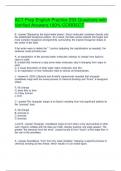ACT Prep English Practice 293 Questions with
Verified Answers,100% CORRECT
B - answer-*Bypassing the liquid water phase*, those molecules condense directly onto
the established hexagonal pattern. As a result, the flake grows outward into bigger and
more complex hexagonal arrangements surrounding the original hexagonal shape at
the center of the flake.
If the writer were to delete the * * portion (adjusting the capitalization as needed), the
sentence could primarily lose:
A. an explanation of the process water molecules undergo to change from liquid to
vapor to solid.
B. a detail that mentions a step some water molecules skip in changing from vapor to
solid.
C. a visual description of what water vapor molecules look like.
D. an explanation of how molecules react to various air temperatures.
J - answer-In 2009, Libbrecht and Arnold's experiments revealed that triangular
snowflakes begin with the same process of chemical bonding and *forms* a hexagonal
shape.
F. No change
G. were they to form
H. if they formed
J. form
C - answer-The triangular shape is an illusion resulting from one significant addition to
the *process* dust.
A. No change
B. process is
C. process:
D. process;
J and B - answer-Triangular snowflakes begin to form when a tiny dust particle or other
such impurity collides with the flake as it falls, thereby pushing one edge upward. The
greater *the pressure from the wind,* causes bonds to form *quick* at this edge than in
the rest of the snowflake.
A - answer-Snowflakes *form from tiny water droplets,* following a specific process of
chemical bonding as they freeze, which results in a six-sided figure.
,A. No change
B. form, from tiny, water droplets,
C. form from tiny, water, droplets
D. form, from tiny water droplets
J - answer-The rare "triangular" snowflake, *similarly,* confounded scientists for years
because it apparently defied the basic laws of chemistry.
F. No change
G. for example,
H. additionally,
J. however,
D - answer-The seemingly triangular shape of those snowflakes suggests *that forming*
through a different process of chemical bonding.
A. No change
B. the manner in which formation
C. which had formed
D. that they form
H - answer-By re-creating snowflake formation, *a discovery has revealed to scientists
Kenneth Libbrecht and Hannah Arnold the cause of this apparent variation.*
F. No change
G. the discovery of the cause of this apparent variation has been made by scientists
Kenneth Libbrecht and Hannah Arnold
H. scientists Kenneth Libbrecht and Hannah Arnold have discovered the cause of this
apparent variation.
J. the cause of this apparent variation has been discovered by scientists Kenneth
Libbrecht and Hannah Arnold
B - answer-Snowflakes begin to form when water in the atmosphere *freezes it causes*
the water molecules to bond into a hexagonal shape.
A. No change
B. freezes, causing
C. freezes, it causes
D. freezes, this causes
J - answer-During the flake's descent from Earth's upper atmosphere, other water vapor
molecules *bumps* into the hexagonal structure.
F. No change
,G. pressure from the wind, which
H. the pressure, as the wind
J. pressure from the wind
A. No change
B. more quickly
C. most quickly
D. quickest
G - answer-The resulting snowflake has three long sides and three sides that are so
short they are difficult to detect. Although these snowflakes appear to have a triangular
*shape--*they actually have a hexagonal pattern.
F. No change
G. shape,
H. shape;
J. shape:
F. No change
G. has bumped
H. bumped
J. bump
A - answer-Such snowflakes offer evidence that even when impurities interfere, *the
basic laws of chemistry still apply.*
Which choice most effectively concludes the sentence and the essay?
A. No change
B. scientists can be certain that a solution to even the most confusing event will be
found
C. snowflakes will still fall if atmospheric conditions are favorable.
D. snowflakes come in many different shapes and sizes.
H - answer-Bundled up in wool sweaters and thick *coats, and we watched* the sun
setting on Mt. Fuji in Japan.
F. No change
G. coats while watching
H. coats, we watched
J. coats watching
B - answer-It was August and our clothes were stifling, but we *would have needed* the
warmth from our bodies sealed around us as we hiked into the high altitudes.
, A. No change
B. would need
C. will need
D. need
J - answer-The trail gradually changed from compact dirt to a jumble of volcanic rocks.
We tried to steady ourselves with our walking sticks but slipped and stumbled *because
of the jumbled rocks we were slipping on.*
F. No change
G. even though we used our walking sticks.
H. despite any efforts to remain steady.
J. with each step.
C - answer-Every thousand feet, we came to a small station constructed of tin and
cement, barely able to block the wind. At each one, we noted the roof *piled high on*
fallen rocks and felt both unsettled and reassured by this evidence of the station's
protective ability.
A. No change
B. piling high with
C. piled high with
D. piling high on
H - answer-We rested uneasily for a moment as a clerk burned the station brand into
our walking *sticks which it was proof of* our progress through the darkness.
F. No change
G. sticks, it was proof of
H. sticks, proof of
J. sticks proved
A - answer-As we neared the summit, the whole group of hikers--thinly spread across
the mountain for *most* of the route--condensed, forming an illuminated line along the
trail.
A. No change
B. the most part
C. majority
D. more
F - answer-As we neared the summit, the whole group of hikers--thinly spread across
the mountain for most of the route--condensed, *forming* an illuminated line along the
trail.




